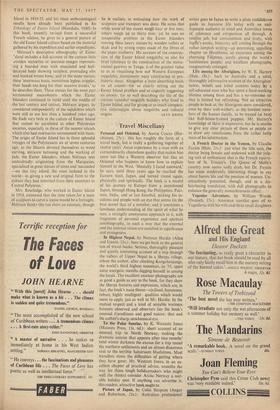Pacific Pre-History
Easter Island: A Stone-Age Civilisation of the Pacific. By Alfred Metraux. Translated by Michael Bullock. (Deutsch, 21s.) EASTER ISLAND was discovered by the Western European world on Easter Day, 1722, when the Dutch Admiral Roggeveen landed there. The Dutchmen caught sight of some of the stone statues for which the island is now so famous; they speculated how 'naked savages' could have built such large monuments and decided they must be 'idols' made of clay. Ever -since this first solution of the mystery of Easter Island, the origins of the inhabitants of this most remote island, and particularly the origins of its great stone figures and its inscribed pieces of wood, have been matters of controversy surrounded with a special aura of strangeness. The island has been seen as the last rerinant of a continent sunk below the sea—Atlantis or Mu; and there has been a general reluctance to credit the ancestors of the existing Easter Islanders with having built the stone figures. A vanished super-race has been postulated, Elliot Smith and Perry bringing it from Egypt and Indonesia, Thor Heyerdahl recently from Peru and North America. The in- scribed tablets have been compared by De Hdvesy with the script of Mohenjodaro and Harappa; Heine-Geldern found affinities between the Easter signs and a south Chinese script on the one hand, and the script of the Cuna Indians of Panama on the other.
Into this free-for-all of speculation, prejudice and argument comes Alfred Metraux with a book distinguished by its scholarship, fairness and moderation. Trained in Oriental languages and anthropology at the Sorbonne, and now a mem- ber of the social sciences department of UNESCO, he has travelled widely in Africa, America and the Pacific and held important anthropological appointments at Tucuman, Honolulu and Yale. He was the ethnologist on the Franco-Belgian scientific expedition to Easter
Island in 1934-35, and his main anthropological results have already been published in his Ethnology of Easter Island (Honolulu, 1940). In this book, recently revised from a successful French edition, he gives us a general picture of the old Easter Island culture based on the material gathered by his expedition and earlier expeditions.
Metraux's descriptive ethnography. Of Easter 'sland includes a full accodnt of the curious little
• wooden statuettes or ancestor-images represent- ing a bearded man with emaciated and half- decayed body showing vertebrre, protruding ribs and hooked breast bone; and of the stone statues, these 'enormous busts, monstrous legless cripples, their heads too long for their massive trunks,' as he describes them. These statues for the most part surmounted mausoleums which the Easter Islanders continued to build until the middle of the last century and cannot, Metraux argues, be considered independently of the sepulchres which were still in use less than a hundred years ago. , He finds very little in the culture of Easter Island that cannot be paralleled in other Polynesian societies, especially in those of the nearest islands - which also had mortuaries surmounted with busts. The origin of Easter Island lies in those splendid voyages of the Polynesians six or'seven centuries ago; as the Maoris devoted themselves to wood 'carving, intricate tattooing and the working of jade, the Easter Islanders, whom Metraux sees undoubtedly originating from the Marquesas, specialised in great statues of stone and 'succeeded —on this tiny island, the most isolated in the world—in giving a new and original form to the culture they had inherited from their ancestors in Central Polynesia.'
Mrs. Routledge, who worked in Easter Island in 1914, estimated that the time taken for a team , of sculptors to carve a statue would be a fortnight.
• Metraux thinks this too short an estimate, though
he is realistic in estimating how the work of sculpture and transport was done. He notes that while some of the stones weigh four or five tons, others weigh up to thirty tons; yet he sees no insuperable problem in the Easter Islanders moving these heavy statues by wooden rollers or skids and by strong ropes made of the fibres of the paper mulberry. His account of the construc- tion of the Easter Island megaliths, as also his brief reference to the construction of the monu- mental gateway in Tonga, is of the greatest value to us in visualising how out Western European. megalithic monuments were constructed in pre- historic times. Altogether a most absorbing book. on all counts—for so clearly setting out the Easter Island problem and so cogently suggesting -its answer, for so well describing the life of the Curious cannibal megalith builders who lived in • Easter Island, and for giving us so Much compara- tive information about megaliths and cultural



































 Previous page
Previous page